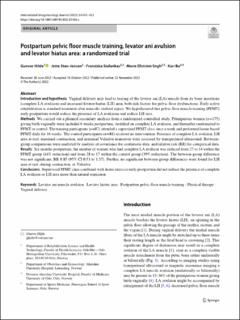| dc.contributor.author | Hilde, Gunvor | |
| dc.contributor.author | Stær-Jensen, Jette | |
| dc.contributor.author | Siafarikas, Franziska | |
| dc.contributor.author | Engh, Anna Marie Ellström | |
| dc.contributor.author | Bø, Kari | |
| dc.date.accessioned | 2023-02-20T12:51:19Z | |
| dc.date.available | 2023-02-20T12:51:19Z | |
| dc.date.created | 2022-12-05T13:41:30Z | |
| dc.date.issued | 2022-11-23 | |
| dc.identifier.citation | International Urogynecology Journal. 2022, 1-11. | en_US |
| dc.identifier.issn | 0937-3462 | |
| dc.identifier.issn | 1433-3023 | |
| dc.identifier.uri | https://hdl.handle.net/11250/3052374 | |
| dc.description.abstract | Introduction and hypothesis Vaginal delivery may lead to tearing of the levator ani (LA) muscle from its bony insertions (complete LA avulsion) and increased levator hiatus (LH) area, both risk factors for pelvic foor dysfunctions. Early active rehabilitation is standard treatment after musculo-skeletal injury. We hypothesized that pelvic foor muscle training (PFMT) early postpartum would reduce the presence of LA avulsions and reduce LH area. Methods We carried out a planned secondary analysis from a randomized controlled study. Primiparous women (n=175) giving birth vaginally were included 6 weeks postpartum, stratifed on complete LA avulsion, and thereafter randomized to PFMT or control. The training participants (n=87) attended a supervised PFMT class once a week and performed home-based PFMT daily for 16 weeks. The control participants (n=88) received no intervention. Presence of complete LA avulsion, LH area at rest, maximal contraction, and maximal Valsalva maneuver were assessed by transperineal ultrasound. Betweengroup comparisons were analyzed by analysis of covariance for continuous data, and relative risk (RR) for categorical data. Results Six months postpartum, the number of women who had complete LA avulsion was reduced from 27 to 14 within the PFMT group (44% reduction) and from 28 to 17 within the control group (39% reduction). The between-group diference was not signifcant, RR 0.85 (95% CI 0.53 to 1.37). Further, no signifcant between-group diferences were found for LH area at rest, during contraction, or Valsalva. Conclusions Supervised PFMT class combined with home exercise early postpartum did not reduce the presence of complete LA avulsion or LH area more than natural remission. | en_US |
| dc.language.iso | eng | en_US |
| dc.publisher | Springer | en_US |
| dc.relation.ispartofseries | International Urogynecology Journal;Volume 34, issue 2 | |
| dc.rights | Navngivelse 4.0 Internasjonal | * |
| dc.rights.uri | http://creativecommons.org/licenses/by/4.0/deed.no | * |
| dc.title | Postpartum pelvic floor muscle training, levator ani avulsion and levator hiatus area: a randomized trial | en_US |
| dc.type | Peer reviewed | en_US |
| dc.type | Journal article | en_US |
| dc.description.version | publishedVersion | en_US |
| dc.rights.holder | © The Author(s) 2022 | en_US |
| cristin.ispublished | true | |
| cristin.fulltext | original | |
| cristin.qualitycode | 1 | |
| dc.identifier.doi | https://doi.org/10.1007/s00192-022-05406-z | |
| dc.identifier.cristin | 2088789 | |
| dc.source.journal | International Urogynecology Journal | en_US |
| dc.source.volume | 34 | en_US |
| dc.source.issue | 2 | en_US |
| dc.source.pagenumber | 413–423 | en_US |

